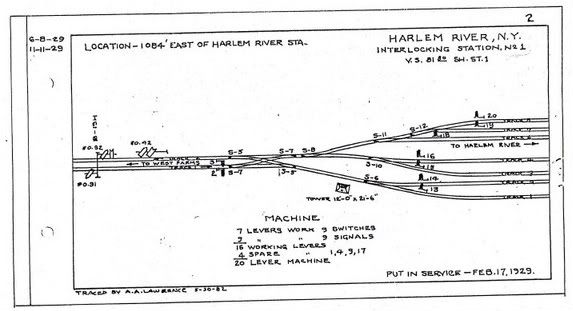So a real mystery came up the other day! A generous fellow who wishes to remain anonymous sent me a scan of an NYW&B train order! I never saw one before, so I thought I'd share it with everyone:
http://nywbry.com/gallery_tickets.php
It's dated 1936. Using a 1934 NYW&B employee timetable, I was able to identify all of the trains in question and figure out why the order was written. But one mystery question remains. "Rockland Avenue" is used as a "station" (a named location on the railroad). My 1934 NYW&B makes no reference to "Rockland Avenue" anywhere. So how can a NYW&B crew reasonably be expected to know where it is?
Well I know where it is. It's a couple miles down the road from my apartment. It's an overpass over the New Haven mainline. Immediately to the west was SS 24, which controlled a universal crossover on the New Haven. Immediately to the east of Rockland Ave., there was also a switch that left the main and crossed the NYW&B on diamonds to reach the freight yard in Mamaroneck.
On the NYW&B, immediately east of those diamonds was a universal crossover that allowed connections between Track 1 and Track 2 on the Westchester. The only other crossovers on the Port Chester Branch were at North Avenue and Port Chester, so most likely that's why the operator at CA gave the other train authority between Port Chester and "Rockland Ave." But why would an operator violate the rules and write an order giving working authority to a station that does not exist in the timetable?
But why isn't Rockland Ave. in the timetable? Well, my 1934 timetable does discuss SS 24 as a landmark, even though it's not a station on the NYWB. But certainly crews would know about SS 24... but the New Haven closed SS 24 in 1935 and remoted its functions to SS 26 in Rye (what PC and MN called "PIKE"). So that leads to several questions from my friend Josh and I...
- After SS 24 closed, did "Rockland Ave" become a station in the NYW&B ETT? in the New Haven ETT?
- We were also trying to figure out what tower controlled the NYW&B crossover. The only NYW&B towers on the Port Chester Branch were NR (North Avenue) and PC (Port Chester)... when NR was built, that was the temporary end of the line. Could SS 24 have also controlled the NYWB's crossover? Could the NYW&B's crossover have been manual flopovers, not electric switches?
- Anyone have a pipe diagram for SS 26 before and after 1935?
- Anyone have a pipe diagram for SS 24 after 1929 (When the NYWB was built)?
- Am I crazy for asking all these questions?
-otto-
http://nywbry.com/gallery_tickets.php
It's dated 1936. Using a 1934 NYW&B employee timetable, I was able to identify all of the trains in question and figure out why the order was written. But one mystery question remains. "Rockland Avenue" is used as a "station" (a named location on the railroad). My 1934 NYW&B makes no reference to "Rockland Avenue" anywhere. So how can a NYW&B crew reasonably be expected to know where it is?
Well I know where it is. It's a couple miles down the road from my apartment. It's an overpass over the New Haven mainline. Immediately to the west was SS 24, which controlled a universal crossover on the New Haven. Immediately to the east of Rockland Ave., there was also a switch that left the main and crossed the NYW&B on diamonds to reach the freight yard in Mamaroneck.
On the NYW&B, immediately east of those diamonds was a universal crossover that allowed connections between Track 1 and Track 2 on the Westchester. The only other crossovers on the Port Chester Branch were at North Avenue and Port Chester, so most likely that's why the operator at CA gave the other train authority between Port Chester and "Rockland Ave." But why would an operator violate the rules and write an order giving working authority to a station that does not exist in the timetable?
But why isn't Rockland Ave. in the timetable? Well, my 1934 timetable does discuss SS 24 as a landmark, even though it's not a station on the NYWB. But certainly crews would know about SS 24... but the New Haven closed SS 24 in 1935 and remoted its functions to SS 26 in Rye (what PC and MN called "PIKE"). So that leads to several questions from my friend Josh and I...
- After SS 24 closed, did "Rockland Ave" become a station in the NYW&B ETT? in the New Haven ETT?
- We were also trying to figure out what tower controlled the NYW&B crossover. The only NYW&B towers on the Port Chester Branch were NR (North Avenue) and PC (Port Chester)... when NR was built, that was the temporary end of the line. Could SS 24 have also controlled the NYWB's crossover? Could the NYW&B's crossover have been manual flopovers, not electric switches?
- Anyone have a pipe diagram for SS 26 before and after 1935?
- Anyone have a pipe diagram for SS 24 after 1929 (When the NYWB was built)?
- Am I crazy for asking all these questions?
-otto-
----------------------------------------------
Moderator: New York State Railfan :: New York Central :: Toy Trains
NYW&B Fan Site :: A Magazine I Read Often :: A Museum I Volunteer At
Moderator: New York State Railfan :: New York Central :: Toy Trains
NYW&B Fan Site :: A Magazine I Read Often :: A Museum I Volunteer At
